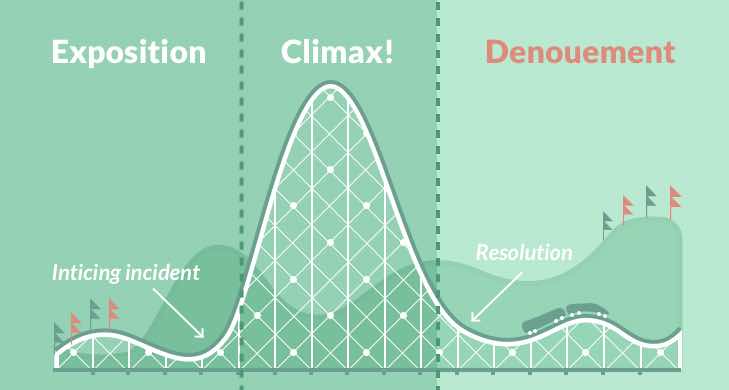Conceptual and Theoretical
- Linear – Film narratives are usually linear. That means we see the events of the story unfolding in the order in which they occurred.
- Chronological – Time order.
- Sequential – In film, a sequence is a series of scenes that form a distinct narrative unit, which is usually connected either by a unity of location or a unity of time. The sequence is one of a hierarchy of structural units used to describe the structure of films in varying degrees of granularity.
- Circular structure – In a circular narrative, the story ends where it began. Although the starting and ending points are the same, the characters undergo a transformation, affected by the story’s events.
- Time based –
- Narrative arc –
- Freytag’s Pyramid – a paradigm of dramatic structure outlining the seven key steps in successful storytelling: exposition, inciting incident, rising action, climax, falling action, resolution, and denouement.
- exposition –
- inciting incident –
- rising action –
- climax –
- falling action –
- resolution –
- denouement –
- Beginning / middle / end –
- Equilibrium –
- Disruption –
- New equilibrium –
- Peripeteia – Change in fortune.
- Anagnoresis – Dramatic Revelation.
- Catharsis – Good Virtue.
- The 3 Unities: Action, Time, Place –
- flashback / flash forward –
- Foreshadowing –
- Ellipsis –
- Pathos –
- empathy –
- diegetic / non-diegetic –
- slow motion –
- genre –
- theme –
Synopsis
My film is going to be about a girl who has been shielded from the real world all her life. She has only been around her two parents and her auntie her whole life. She was never allowed to leave the house. Home schooled all her life and her parents controlled everything. They had conditioned her to believe that anything outside their home was a danger but obviously as a growing child, her curiosity grew also. The main character – the 17 year old girl – does look to escape her home as she wants to explore the outside world.
At age 10 her curiosity started to grow and she started to look more out the windows but all she ever did see were foggy skies as her house was so far up on a hill, secluded from any other civilisation. From 11, she started to notice strange deliveries during the night as she always seen a bright headlight shine through her window at exactly 1:30am. When she was younger she believed it was a star as that was what she was lead to believe.
This film will be targeting teenagers who may relate to some extent. Maybe not relate literally but can relate figuratively speaking. A viewer might feel trapped in their own life therefore would seek comfort through this film because it may or may not be a similar experience.
Examples
Todorov
Equilibrium, the story constructs a stable world at the outset of the narrative. Key characters are presented as part of that stability.
Disruption, Oppositional forces – the actions of a villain, perhaps, or some kind of calamity – destabilise the story’s equilibrium. Lead protagonists attempt to repair the disruption caused.
New Equilibrium, disruption is repaired and stability restored. Importantly, the equilibrium achieved at the end of the story is different to that outlined at the start. The world is transformed.
Freytags Pyramid
Exposition, Climax, Denouement

Vladimir Propp
Character Types and Function
Propp argued that stories are character driven and that plots develop from the decisions and actions of characters and how they function in a story.
That is not to say that all characters are the same, but rather to suggest that all stories draw on familiar characters performing similar functions to provide familiar narrative structures.
Propp identifies the types of characters:
- The hero: he identifies two significant types – the seeker-hero and the victim-hero.
- The Villain: fights or pursues the hero and must be defeated in order for hero to accomplish their quest.
- The Princess and Princess’ Father: princess usually represents the reward for the hero’s quest.
Claude Levi-Strauss (Binary Oppositions)
Seymour Chatman: Satellites & Kernels
- Kernels: key moments in the plot / narrative structure
- Satellites: embellishments, developments, aesthetics
Roland Barthes: Proairetic and Hermenuetic Codes
- Proairetic code: action, movement, causation
- Hermenuetic code: reflection, dialogue, character or thematic development
- Enigma code: the way in which intrigue and ideas are raised – which encourage an audience to want more information.



